Exploring the Multi-Sensory Coupling Relationship of Open Space on a Winter Campus
Abstract
:1. Introduction
2. Research Methodology
2.1. Study Area
2.2. Experimental Design
2.2.1. Sound Selection
2.2.2. Experimental Data Collection
2.2.3. Subjective Questionnaires
2.3. Thermal and Visual Indices
2.4. Statistical Analysis
3. Descriptive Analysis
3.1. Attributes of Volunteers
3.2. Meteorological Parameters
3.3. Thermal Sensation and Comfort of Volunteers
3.4. Universal Thermal Climate Index (UTCI)
3.5. Correlation of Thermal, Acoustic, and Visual Comfort Indicators
4. Interaction between Acoustic and Thermal Comfort
4.1. Effects of the Acoustic Environment on Thermal Perception
4.1.1. Effect of Sound Type on Thermal Perception
4.1.2. Impact of Acoustic Comfort on Thermal Perception and Thermal Comfort
4.2. Effects of Thermal Environment on Acoustic Perception
4.2.1. Effect of Universal Thermal Climate Index (UTCI) on Acoustic Perception and Acoustic Comfort
4.2.2. Effect of Thermal Comfort on Acoustic Sensation and Acoustic Comfort
5. Interaction between Visual and Thermal Comfort
5.1. Effects of Visual Environment on Thermal Perception
5.1.1. Effect of Illumination Intensity on Thermal Sensation and Thermal Comfort
5.1.2. Influence of Visual Comfort on Thermal Sensation and Thermal Comfort
5.2. Effect of Thermal Environment on Visual Perception
5.2.1. Effect of Universal Thermal Climate Index (UTCI) on Light Perception and Visual Comfort
5.2.2. Impact of Thermal Comfort on Light Perception and Visual Comfort
6. Discussion and Analysis
6.1. Influence of Acoustic–Thermal Environments
6.2. Influence of the Visual–Thermal Environment
6.3. Limitations and Future Work
7. Conclusions
Author Contributions
Funding
Data Availability Statement
Conflicts of Interest
Appendix A
| 2 Perception and Evaluation of Campus Space Questionnaire (Winter)—Chuangxin Building | |||||||||||||||
|---|---|---|---|---|---|---|---|---|---|---|---|---|---|---|---|
| 1. Gender * ○Male ○Female | 2. Height:_________ (CM) | 3. Weight: _________ (KG) | |||||||||||||
| 4. Native Place: _________ | 5. Age: _________ | ||||||||||||||
| 6. Education | |||||||||||||||
| ○Secondary/high school (including vocational high school and high technology) and below ○College ○Bachelor’s degree ○Master’s degree ○Doctor’s degree | |||||||||||||||
| 7. Please select all of your current clothing (multiple choice) * Tops: | |||||||||||||||
| □Vest | □T-shirt | □Thermal underwear | |||||||||||||
| □Long-sleeved T-shirt | □Thin coat | □Overcoat | |||||||||||||
| □Thick coat | □Sweater | □Down jacket | |||||||||||||
| 8. Bottoms: [Multiple choice] * | |||||||||||||||
| □Shorts | □Short skirt | □Leggings | |||||||||||||
| □Capri trousers | □Knee-length skirt | □Long johns | |||||||||||||
| □Pants | □Short sleeve dress | □Long woolen underwear | |||||||||||||
| □Fleece-lined pants | □Long sleeve dress | ||||||||||||||
| 9. Shoes and Socks: [multiple choice] * | |||||||||||||||
| □Socks | □Sandal | □Sneaker | |||||||||||||
| □Stocking | □Shoes | □Boot | |||||||||||||
| 10. Other: [Multiple choice] * | |||||||||||||||
| □Cap | □Earmuff | □Mask | |||||||||||||
| □Cooling arm sleeves | □Glove | □Scarf | |||||||||||||
| □None | |||||||||||||||
| 11. The light in your current environment makes you feel: [Single choice] * | |||||||||||||||
| ○-3 Very dark | ○−2 Dark | ○−1 Slightly dark | ○0 Moderate | ○+1 Slightly bright | ○+2 Bright | ○+3 Very bright | |||||||||
| 12. The view makes you feel: * | |||||||||||||||
| ○−2 Very uncomfortable | ○−1 Uncomfortable | ○0 Moderate | ○+1 Comfortable | ○+2 Very comfortable | |||||||||||
| 13. The main types of sound in this scene are: * | |||||||||||||||
| □vehicle traffic | □human speech | □Running water | □ birds and insects | □wind and leaf sounds | □music or radio | ||||||||||
| 14. The loudness of the current ambient sound makes you feel that: * | |||||||||||||||
| ○−3 Very quiet | ○−2 Quiet | ○−1 Slightly quiet | ○0 Moderate | ○+1 Slightly noisy | ○+2 Noisy | ○+3 Very noisy | |||||||||
| 15. The sound you heard made you feel: [Single choice] * | |||||||||||||||
| ○−2 Very uncomfortable | ○−1 Uncomfortable | ○0 Moderate | ○+1 Comfortable | ○+2 Very comfortable | |||||||||||
| 16. In the current environment, you feel that: * | |||||||||||||||
| ○−3 Very cold | ○−2 Cold | ○−1 Slightly cold | ○0 Moderate | ○+1 Slightly hot | ○+2 hot | ○+3 Very hot | |||||||||
| 17. Based on your current sense of body, you feel that the environment: * | |||||||||||||||
| ○−2 Very uncomfortable | ○−1 Uncomfortable | ○0 Moderate | ○+1 Comfortable | ○+2 Very comfortable | |||||||||||
Appendix B
| Clothing | Clothing Thermal Resistance | Clothing | Clothing Thermal Resistance | Clothing | Clothing Thermal Resistance |
|---|---|---|---|---|---|
| Ves | 0.06 | T-shirt | 0.08 | Long-sleeved T-shirt | 0.25 |
| Thick coat | 0.4 | Thick coat | 0.48 | Sweater | 0.28 |
| Thermal underwear | 0.20 | Overcoat | 0.6 | Down jacket | 1.09 |
| Shorts | 0.06 | Capri trousers | 0.2 | ||
| Pants | 0.28 | Long johns | 0.2 | Knee-length skirt | 0.33 |
| Leggings | 0.28 | Fleece-lined pants | 0.28 | Short sleeve dress | 0.19 |
| Long woolen underwear | 0.2 | Short skirt | 0.23 | Long sleeve dress | 0.47 |
| Socks | 0.02 | Stocking | 0.02 | Sandal | 0.02 |
| Sneaker | 0.04 | Boot | 0.1 | Shoes | 0.04 |
| None | 0 | Cap | 0.05 | Glove | 0.05 |
| Scarf | 0.05 |
Appendix C
| Sum of Squares | df | Mean Square | F | Sig. | ||
|---|---|---|---|---|---|---|
| Ta | Between Groups | 28.852 | 8 | 26.107 | 814.219 | 0.000 * |
| Within Groups | 10.100 | 315 | 0.032 | |||
| Total | 218.952 | 323 | ||||
| RH | Between Groups | 856.641 | 8 | 107.080 | 134.166 | 0.000 * |
| Within Groups | 251.406 | 315 | 0.798 | |||
| Total | 1108.047 | 323 | ||||
| Va | Between Groups | 5.675 | 8 | 0.709 | 8.805 | 0.000 * |
| Within Groups | 25.379 | 315 | 0.081 | |||
| Total | 31.054 | 323 | ||||
| G | Between Groups | 616,017.901 | 8 | 77,002.238 | 109.311 | 0.000 * |
| Within Groups | 221,895.432 | 315 | 704.430 | |||
| Total | 837,913.334 | 323 | ||||
| Tg | Between Groups | 59.012 | 8 | 7.376 | 86.841 | 0.000 * |
| Within Groups | 3.058 | 36 | 0.085 | |||
| Total | 62.070 | 44 | ||||
| Illuminance | Between Groups | 5,235,427,812.494 | 8 | 654,428,476.562 | 127.791 | 0.000 * |
| Within Groups | 419,930,323.528 | 82 | 5,121,101.506 | |||
| Total | 5,655,358,136.021 | 90 |
Appendix D
| S1 | S2 | S3 | S4 | S5 | S6 | S7 | S8 | S9 | |
|---|---|---|---|---|---|---|---|---|---|
| Ta (°C) | |||||||||
| Max | 22.06 | 22.16 | 22.13 | 22.46 | 22.62 | 22.22 | 20.55 | 21.84 | 20.05 |
| Min | 21.98 | 22.09 | 21.98 | 21.38 | 22.22 | 20.90 | 19.98 | 20.94 | 19.83 |
| Mean ± SD | 22.06 ± 0.06 | 22.11 ± 0.02 | 22.07 ± 0.05 | 21.41 ± 0.02 | 22.39 ± 0.14 | 21.41 ± 0.40 | 20.29 ± 0.20 | 21.39 ± 0.25 | 19.91 ± 0.07 |
| RH (%) | |||||||||
| Max | 38.43 | 37.91 | 40.89 | 38.30 | 37.08 | 39.62 | 43.65 | 41.27 | 40.40 |
| Min | 36.50 | 36.78 | 38.00 | 36.05 | 33.86 | 35.36 | 38.68 | 35.55 | 38.45 |
| Mean ± SD | 37.44 ± 0.47 | 37.2 ± 0.26 | 38.74 ± 0.64 | 36.99 ± 0.54 | 35.16 ± 0.79 | 37.78 ± 1.12 | 41.3 ± 1.30 | 38.48 ± 1.52 | 39.44 ± 0.57 |
| Va(m/s) | |||||||||
| Max | 0.67 | 1.00 | 0.67 | 0.65 | 1.34 | 0.68 | 0.33 | 1.34 | 1.00 |
| Min | 0.00 | 0.00 | 0.00 | 0.00 | 0.00 | 0.00 | 0.00 | 0.00 | 0.00 |
| Mean ± SD | 0.05 ± 0.14 | 0.16 ± 0.27 | 0.04 ± 0.13 | 0.15 ± 0.18 | 0.426 ± 0.52 | 0.10 ± 0.17 | 0.06 ± 0.13 | 0.35 ± 0.42 | 0.27 ± 0.29 |
| G(W/m2) | |||||||||
| Max | 65.6 | 63.1 | 168.1 | 66.4 | 464.4 | 36.9 | 19.4 | 96.9 | 44.7 |
| Min | 44.4 | 61.9 | 46.9 | 54.2 | 45.6 | 33.1 | 11.9 | 30.6 | 38.5 |
| Mean ± SD | 47.43 ± 3.88 | 62.30 ± 0.57 | 66.26 ± 18.43 | 61.24 ± 5.36 | 169.31 ± 75.75 | 35.7 ± 1.20 | 13.05 ± 1.52 | 55.56 ± 14.66 | 42.06 ± 2.10 |
| UTCI (°C) | |||||||||
| Max | 24.5 | 25.4 | 24.9 | 21.7 | 26.7 | 23.9 | 20.7 | 20.5 | 18.3 |
| Min | 24.1 | 24.9 | 24.3 | 21.5 | 26.1 | 23.5 | 19.9 | 20.0 | 17.9 |
| Mean ± SD | 24.4 ± 0.10 | 25 ± 0.12 | 24.6 ± 0.13 | 21.6 ± 0.05 | 26.4 ± 0.15 | 23.7 ± 0.10 | 20.23 ± 0.19 | 20.2 ± 0.14 | 18.1 ± 0.12 |
| Illuminance (klux) | |||||||||
| Max | 9.84 | 11.14 | 14.07 | 14.46 | 31.07 | 6.13 | 3.01 | 17.42 | 6.75 |
| Min | 3.98 | 10.72 | 1.98 | 12.93 | 28.73 | 5.66 | 2.75 | 7.70 | 5.93 |
| Mean ± SD | 7.00 ± 2.71 | 10.99 ± 0.14 | 5.33 ± 3.44 | 13.82 ± 0.55 | 29.67 ± 0.89 | 5.86 ± 0.21 | 2.9 ± 0.85 | 13.4 ± 5.12 | 6.34 ± 0.37 |
Appendix E
| df | F | Sig. | df | F | Sig. | ||||
|---|---|---|---|---|---|---|---|---|---|
| TSV | UTCI | 2 | 14.507 | 0.000 * | TCV | UTCI | 2 | 1.265 | 0.283 |
| STP | 5 | 1.729 | 0.125 | STP | 5 | 1.872 | 0.097 | ||
| UTCI × STP | 9 | 1.688 | 0.088 | UTCI × STP | 9 | 0.668 | 0.738 | ||
| TSV | UTCI | 2 | 13.643 | 0.000 * | TCV | UTCI | 2 | 7.78 | 0.000 * |
| ACV | 4 | 3.169 | 0.013 * | ACV | 4 | 89.163 | 0.000 * | ||
| UTCI × ACV | 8 | 2.069 | 0.036 * | UTCI × ACV | 8 | 1.599 | 0.121 | ||
| ASV | UTCI | 2 | 23.614 | 0.000 * | ACV | UTCI | 2 | 5.236 | 0.005 * |
| STP | 5 | 1.024 | 0.402 | STP | 5 | 3.812 | 0.002 * | ||
| UTCI × STP | 9 | 2.637 | 0.005 * | UTCI × STP | 9 | 2.151 | 0.023 * | ||
| ASV | STP | 5 | 1.101 | 0.358 | ACV | STP | 5 | 2.673 | 0.021 * |
| TCV | 4 | 6.06 | 0.000 * | TCV | 4 | 107.372 | 0.000 * | ||
| STP × TCV | 20 | 0.937 | 0.539 | STP × TCV | 20 | 1.601 | 0.046 * | ||
| TSV | UTCI | 2 | 38.919 | 0.000 * | TCV | UTCI | 2 | 26.496 | 0.000 * |
| LUX | 2 | 11.691 | 0.000 * | LUX | 2 | 13.611 | 0.000 * | ||
| UTCI × LUX | 1 | 7.01 | 0.008 * | UTCI × LUX | 1 | 7.224 | 0.007 * | ||
| TSV | UTCI | 2 | 58.165 | 0.000 * | TCV | UTCI | 2 | 3.058 | 0.048 * |
| VCV | 4 | 1.929 | 0.104 | VCV | 4 | 132.513 | 0.000 * | ||
| UTC × VCV | 6 | 1.35 | 0.232 | UTCI × VCV | 6 | 3.881 | 0.001 * | ||
| SSV | UTCI | 2 | 15.655 | 0.000 * | VCV | UTCI | 2 | 17.213 | 0.000 * |
| LUX | 2 | 44.54 | 0.000 * | LUX | 2 | 10.673 | 0.000 * | ||
| UTC × LUX | 1 | 1.825 | 0.177 | UTCI × LUX | 1 | 19.515 | 0.000 * | ||
| SSV | LUX | 2 | 40.76 | 0.000 * | VCV | LUX | 2 | 1.231 | 0.293 |
| TCV | 4 | 3.456 | 0.008 * | TCV | 4 | 132.507 | 0.000 * | ||
| LUX × TCV | 8 | 2.627 | 0.008 * | LUX × TCV | 8 | 2.306 | 0.019 * |
References
- Martinelli, L.; Lin, T.-P.; Matzarakis, A. Assessment of the Influence of Daily Shadings Pattern on Human Thermal Comfort and Attendance in Rome during Summer Period. Build. Environ. 2015, 92, 30–38. [Google Scholar] [CrossRef]
- Niu, J.; Xiong, J.; Qin, H.; Hu, J.; Deng, J.; Han, G.; Yan, J. Influence of Thermal Comfort of Green Spaces on Physical Activity: Empirical Study in an Urban Park in Chongqing, China. Build. Environ. 2022, 219, 109168. [Google Scholar] [CrossRef]
- Lin, T.-P.; Tsai, K.-T.; Hwang, R.-L.; Matzarakis, A. Quantification of the Effect of Thermal Indices and Sky View Factor on Park Attendance. Landsc. Urban Plan. 2012, 107, 137–146. [Google Scholar] [CrossRef]
- Zhang, J.; Chaaban, J. The Economic Cost of Physical Inactivity in China. Prev. Med. 2013, 56, 75–78. [Google Scholar] [CrossRef]
- Li, K.; Wang, L.; Feng, M. Relationship between Built Environments and Risks of Ischemic Stroke Based on Meteorological Factors: A Case Study of Wuhan’s Main Urban Area. Sci. Total Environ. 2021, 769, 144331. [Google Scholar] [CrossRef]
- Paton-Walsh, C.; Rayner, P.; Simmons, J.; Fiddes, S.L.; Schofield, R.; Bridgman, H.; Beaupark, S.; Broome, R.; Chambers, S.D.; Chang, L.T.-C.; et al. A Clean Air Plan for Sydney: An Overview of the Special Issue on Air Quality in New South Wales. Atmosphere 2019, 10, 774. [Google Scholar] [CrossRef]
- Popek, R.; Fornal-Pieniak, B.; Dąbrowski, P.; Chyliński, F. The Role of Spontaneous Flora in the Mitigation of Particulate Matter from Traffic Roads in an Urbanised Area. Sustainability 2023, 15, 7568. [Google Scholar] [CrossRef]
- Du, W.C.; Xia, X.H. How Does Urbanization Affect GHG Emissions? A Cross-Country Panel Threshold Data Analysis. Appl. Energy 2018, 229, 872–883. [Google Scholar] [CrossRef]
- Lai, D.; Zhou, C.; Huang, J.; Jiang, Y.; Long, Z.; Chen, Q. Outdoor Space Quality: A Field Study in an Urban Residential Community in Central China. Energy Build. 2014, 68, 713–720. [Google Scholar] [CrossRef]
- Candas, V.; Dufour, A. Thermal Comfort: Multisensory Interactions? J. Physiol. Anthr. Appl. Hum. Sci. 2005, 24, 33–36. [Google Scholar] [CrossRef]
- Pellerin, N.; Candas, V. Effects of Steady-State Noise and Temperature Conditions on Environmental Perception and Acceptability. Indoor Air 2004, 14, 129–136. [Google Scholar] [CrossRef] [PubMed]
- Nikolopoulou, M.; Baker, N.; Steemers, K. Thermal Comfort in Outdoor Urban Spaces: Understanding the Human Parameter. Sol. Energy 2001, 70, 227–235. [Google Scholar] [CrossRef]
- Nagano, K.; Horikoshi, T. New Comfort Index during Combined Conditions of Moderate Low Ambient Temperature and Traffic Noise. Energy Build. 2005, 37, 287–294. [Google Scholar] [CrossRef]
- Yin, Y.; Zhang, D.; Zhen, M.; Jing, W.; Luo, W.; Feng, W. Combined Effects of the Thermal-Acoustic Environment on Subjective Evaluations in Outdoor Public Spaces. Sustain. Cities Soc. 2022, 77, 103522. [Google Scholar] [CrossRef]
- Tiller, D.K.; Wang, L.M.; Musser, A.; Radik, M.J. Combined Effects of Noise and Temperature on Human Comfort and Performance: 2010 ASHRAE Annual Conference. ASHRAE Trans. 2010, 116, 522–540. [Google Scholar]
- Lam, C.K.C.; Yang, H.; Yang, X.; Liu, J.; Ou, C.; Cui, S.; Kong, X.; Hang, J. Cross-Modal Effects of Thermal and Visual Conditions on Outdoor Thermal and Visual Comfort Perception. Build. Environ. 2020, 186, 107297. [Google Scholar] [CrossRef]
- Kang, J.; Yang, W. Soundscape in Urban Open Public Spaces. World Archit. 2002, 144, 76–79. [Google Scholar]
- Yu, L.; Kang, J. Modeling Subjective Evaluation of Soundscape Quality in Urban Open Spaces: An Artificial Neural Network Approach. J. Acoust. Soc. Am. 2009, 126, 1163–1174. [Google Scholar] [CrossRef]
- Yang, W.; Kang, J. Acoustic Comfort Evaluation in Urban Open Public Spaces. Appl. Acoust. 2005, 66, 211–229. [Google Scholar] [CrossRef]
- Guan, H.; Hu, S.; Lu, M.; He, M.; Mao, Z.; Liu, G. People’s Subjective and Physiological Responses to the Combined Thermal-Acoustic Environments. Build. Environ. 2020, 172, 106709. [Google Scholar] [CrossRef]
- Zhou, Z.; Ye, X.; Chen, J.; Fan, X.; Kang, J. Effect of Visual Landscape Factors on Soundscape Evaluation in Old Residential Areas. Appl. Acoust. 2024, 215, 109708. [Google Scholar] [CrossRef]
- Li, K.; Liu, M. Combined Influence of Multi-Sensory Comfort in Winter Open Spaces and Its Association with Environmental Factors: Wuhan as a Case Study. Build. Environ. 2024, 248, 111037. [Google Scholar] [CrossRef]
- Grahn, P.; Stigsdotter, U.K. The Relation between Perceived Sensory Dimensions of Urban Green Space and Stress Restoration. Landsc. Urban Plan. 2010, 94, 264–275. [Google Scholar] [CrossRef]
- Polat, A.T.; Akay, A. Relationships between the Visual Preferences of Urban Recreation Area Users and Various Landscape Design Elements. Urban For. Urban Green. 2015, 14, 573–582. [Google Scholar] [CrossRef]
- Yang, W.; Moon, H.J. Cross-Modal Effects of Illuminance and Room Temperature on Indoor Environmental Perception. Build. Environ. 2018, 146, 280–288. [Google Scholar] [CrossRef]
- Chen, T.; Pan, H.; Lu, M.; Hang, J.; Lam, C.K.C.; Yuan, C.; Pearlmutter, D. Effects of Tree Plantings and Aspect Ratios on Pedestrian Visual and Thermal Comfort Using Scaled Outdoor Experiments. Sci. Total. Environ. 2021, 801, 149527. [Google Scholar] [CrossRef] [PubMed]
- Samira, L.; Abdou, S.; Reiter, S. Effect of Vegetation Cover on Thermal and Visual Comfort of Pedestrians in Urban Spaces in Hot and Dry Climate. Nat. Technol. 2017, 17, 30–42. [Google Scholar]
- Rosso, F.; Pisello, A.L.; Cotana, F.; Ferrero, M. On the Thermal and Visual Pedestrians’ Perception about Cool Natural Stones for Urban Paving: A Field Survey in Summer Conditions. Build. Environ. 2016, 107, 198–214. [Google Scholar] [CrossRef]
- Astolfi, A.; Corgnati, S.P.; Verso, V.L. Environmental Comfort in University Classrooms—Thermal, Acoustic, Visual and Air Quality Aspects. Research in Building Physics; CRC Press: Boca Raton, FL, USA, 2020. [Google Scholar]
- Ricciardi, P.; Buratti, C. Environmental Quality of University Classrooms: Subjective and Objective Evaluation of the Thermal, Acoustic, and Lighting Comfort Conditions. Build. Environ. 2018, 127, 23–36. [Google Scholar] [CrossRef]
- Wu, H.; Sun, X.; Wu, Y. Investigation of the Relationships between Thermal, Acoustic, Illuminous Environments and Human Perceptions. J. Build. Eng. 2020, 32, 101839. [Google Scholar] [CrossRef]
- Du, M.; Hong, B.-K.; Gu, C.; Li, Y.; Wang, Y. Multiple Effects of Visual-Acoustic-Thermal Perceptions on the Overall Comfort of Elderly Adults in Residential Outdoor Environments. Energy Build. 2023, 283, 112813. [Google Scholar] [CrossRef]
- Echevarria Sanchez, G.M.; Van Renterghem, T.; Sun, K.; De Coensel, B.; Botteldooren, D. Using Virtual Reality for Assessing the Role of Noise in the Audio-Visual Design of an Urban Public Space. Landsc. Urban Plan. 2017, 167, 98–107. [Google Scholar] [CrossRef]
- Li, Z.; Ba, M.; Kang, J. Physiological Indicators and Subjective Restorativeness with Audio-Visual Interactions in Urban Soundscapes. Sustain. Cities Soc. 2021, 75, 103360. [Google Scholar] [CrossRef]
- Liu, J.; Kang, J.; Luo, T.; Behm, H. Landscape Effects on Soundscape Experience in City Parks. Sci. Total Environ. 2013, 454–455, 474–481. [Google Scholar] [CrossRef]
- Van Renterghem, T.; Botteldooren, D. View on Outdoor Vegetation Reduces Noise Annoyance for Dwellers near Busy Roads. Landsc. Urban Plan. 2016, 148, 203–215. [Google Scholar] [CrossRef]
- Jeon, J.Y.; Lee, P.J.; Hong, J.Y.; Cabrera, D. Non-Auditory Factors Affecting Urban Soundscape Evaluation. J. Acoust. Soc. Am. 2011, 130, 3761–3770. [Google Scholar] [CrossRef]
- Nitidara, N.P.A.; Sarwono, J.; Suprijanto, S.; Soelami, F.X.N. The Multisensory Interaction between Auditory, Visual, and Thermal to the Overall Comfort in Public Open Space: A Study in a Tropical Climate. Sustain. Cities Soc. 2022, 78, 103622. [Google Scholar] [CrossRef]
- Kang, J.; Aletta, F.; Gjestland, T.T.; Brown, L.A.; Botteldooren, D.; Schulte-Fortkamp, B.; Lercher, P.; van Kamp, I.; Genuit, K.; Fiebig, A.; et al. Ten Questions on the Soundscapes of the Built Environment. Build. Environ. 2016, 108, 284–294. [Google Scholar] [CrossRef]
- Te Kulve, M.; Schlangen, L.; van Marken Lichtenbelt, W. Interactions between the Perception of Light and Temperature. Indoor Air 2018, 28, 881–891. [Google Scholar] [CrossRef] [PubMed]
- Haldi, F.; Robinson, D. On the Unification of Thermal Perception and Adaptive Actions. Build. Environ. 2010, 45, 2440–2457. [Google Scholar] [CrossRef]
- Li, D.; Sullivan, W.C. Impact of Views to School Landscapes on Recovery from Stress and Mental Fatigue. Landsc. Urban Plan. 2016, 148, 149–158. [Google Scholar] [CrossRef]
- Zijlema, W.L.; Triguero-Mas, M.; Smith, G.; Cirach, M.; Martinez, D.; Dadvand, P.; Gascon, M.; Jones, M.; Gidlow, C.; Hurst, G.; et al. The Relationship between Natural Outdoor Environments and Cognitive Functioning and Its Mediators. Environ. Res. 2017, 155, 268–275. [Google Scholar] [CrossRef] [PubMed]
- Eslamirad, N.; Sepúlveda, A.; De Luca, F.; Sakari Lylykangas, K. Evaluating Outdoor Thermal Comfort Using a Mixed-Method to Improve the Environmental Quality of a University Campus. Energies 2022, 15, 1577. [Google Scholar] [CrossRef]
- Chen, H.; Hong, B.; Qu, H.; Geng, Y.; Su, M. Effects of Acoustic Perception on Outdoor Thermal Comfort in Campus Open Spaces in China’s Cold Region. Buildings 2022, 12, 1518. [Google Scholar] [CrossRef]
- Wang, X.; Chen, Z.; Ma, D.; Zhou, T.; Chen, J.; Jiang, X. Relationship between Visual and Thermal Comfort and Electrodermal Activity in Campus Blue–Green Spaces: A Case Study of Guangzhou, China. Sustainability 2023, 15, 11742. [Google Scholar] [CrossRef]
- Zhen, M.; Chen, Z.; Zou, Q. Combined Effects of Thermal and Acoustic Environments on Outdoor Human Comfort in University Campus. Urban Clim. 2023, 49, 101566. [Google Scholar] [CrossRef]
- Tao, Y.; Lau, S.S.Y.; Gou, Z.; Zhang, J.; Tablada, A. An Investigation of Semi-Outdoor Learning Spaces in the Tropics: Spatial Settings, Thermal Environments and User Perceptions. Indoor Built Environ. 2019, 28, 1368–1382. [Google Scholar] [CrossRef]
- Geng, Y.; Hong, B.; Du, M.; Yuan, T.; Wang, Y. Combined Effects of Visual-Acoustic-Thermal Comfort in Campus Open Spaces: A Pilot Study in China’s Cold Region. Build. Environ. 2022, 209, 108658. [Google Scholar] [CrossRef]
- Dong, W.; Wu, J.; Chen, Y.; Zhou, X. A Bibliometric Review of Research on the Perceptions of Campus Public Spaces. Buildings 2023, 13, 501. [Google Scholar] [CrossRef]
- GB50178-93; Standard of Climatic Regionalization for Architecture. Ministry of Construction of the People’s Republic of China: Beijing, China, 1994; pp. 57–61.
- Wen, X.; Zhu, Y.; Dong, J.; Wang, M.; Dong, J. Effects of Soundscape on Emotion and Attention on Campus Green Space—A Case Study of Fujian Agriculture and Forestry University. Chin. Landsc. Archit. 2021, 37, 88–93. [Google Scholar] [CrossRef]
- Sun, C.-Y. A Street Thermal Environment Study in Summer by the Mobile Transect Technique. Theor. Appl. Clim. 2011, 106, 433–442. [Google Scholar] [CrossRef]
- Xie, Z.; Wang, H.; Zheng, Q.; Lin, W.; Wu, Q. Pollution Characteristics of Airborne Particles in Fuzhou City in 2015. Res. Environ. Sci. 2017, 30, 864–873. [Google Scholar] [CrossRef]
- Zhang, L.; Wei, D.; Hou, Y.; Du, J.; Liu, Z.; Zhang, G.; Shi, L. Outdoor Thermal Comfort of Urban Park—A Case Study. Sustainability 2020, 12, 1961. [Google Scholar] [CrossRef]
- Lin, J.; Chen, S.; Yang, J.; Li, Z. Research on Summer Outdoor Thermal Comfort Based on COMFA Model in an Urban Park of Fuzhou, China. Theor. Appl. Clim. 2024, 155, 2311–2322. [Google Scholar] [CrossRef]
- Axelsson, Ã.; Nilsson, M.E.; Berglund, B. The Swedish Soundscape-Quality Protocol. J. Acoust. Soc. Am. 2012, 131, 3476. [Google Scholar] [CrossRef]
- ASHRAE Standard 55; Thermal Environmental Conditions for Human Occupancy. ANSI/ASHRAE Standard: Atlanta, GA, USA, 2017.
- ISO 7726:1998; Thermal Environment-Instruments and Method for Measuring Physical Quantities. ISO: Geneva, Switzerland, 1998.
- ISO 10551:2019; Ergonomics of the Physical Environment—Subjective Judgement Scales for Assessing Physical Environments. ISO: Geneva, Switzerland, 2019.
- Jendritzky, G.; de Dear, R.; Havenith, G. UTCI—Why Another Thermal Index? Int. J. Biometeorol. 2012, 56, 421–428. [Google Scholar] [CrossRef] [PubMed]
- Li, J.; Liu, N. The Perception, Optimization Strategies and Prospects of Outdoor Thermal Comfort in China: A Review. Build. Environ. 2020, 170, 106614. [Google Scholar] [CrossRef]
- Fang, Z.; Lin, Z.; Mak, C.M.; Niu, J.; Tse, K.T. Investigation into Sensitivities of Factors in Outdoor Thermal Comfort Indices. Build. Environ. 2018, 128, 129–142. [Google Scholar] [CrossRef]
- Pantavou, K.; Theoharatos, G.; Santamouris, M.; Asimakopoulos, D. Outdoor Thermal Sensation of Pedestrians in a Mediterranean Climate and a Comparison with UTCI. Build. Environ. 2013, 66, 82–95. [Google Scholar] [CrossRef]
- ISO 7730:2005(En); Ergonomics of the Thermal Environment—Analytical Determination and Interpretation of Thermal Comfort Using Calculation of the PMV and PPD Indices and Local Thermal Comfort Criteria. ISO: Geneva, Switzerland, 2005.
- Cheung, P.K.; Jim, C.Y. Determination and Application of Outdoor Thermal Benchmarks. Build. Environ. 2017, 123, 333–350. [Google Scholar] [CrossRef]
- Lai, D.; Guo, D.; Hou, Y.; Lin, C.; Chen, Q. Studies of Outdoor Thermal Comfort in Northern China. Build. Environ. 2014, 77, 110–118. [Google Scholar] [CrossRef]
- Thimijan, R.W.; Heins, R.D. Photometric, Radiometric, and Quantum Light Units of Measure: A Review of Procedures for Interconversion. Hortscience 1983, 18, 818–822. [Google Scholar] [CrossRef]
- Zhang, M.; Kang, J. Towards the Evaluation, Description, and Creation of Soundscapes in Urban Open Spaces. Environ. Plann. B 2007, 34, 68–86. [Google Scholar] [CrossRef]
- Nikolopoulou, M.; Steemers, K. Thermal Comfort and Psychological Adaptation as a Guide for Designing Urban Spaces. Energy Build. 2003, 35, 95–101. [Google Scholar] [CrossRef]
- Zhang, L. Study on The Effects of Thermal And Acoustic on Human Comfort. Master’s Thesis, Qingdao University of Technology, Qingdao, China, 2017. [Google Scholar] [CrossRef]
- Brambilla, G.; Maffei, L.; Di Gabriele, M.; Gallo, V. Merging Physical Parameters and Laboratory Subjective Ratings for the Soundscape Assessment of Urban Squares. J. Acoust. Soc. Am. 2013, 134, 782–790. [Google Scholar] [CrossRef] [PubMed]
- Lin, D.; Li, T.; Chen, Z.; Li, L. Effects of Interactions between Thermal and Acoustic Environments on Subjective Comfort Evaluations in Outdoor Public Spaces. J. Asian Archit. Build. Eng. 2023, 1–16. [Google Scholar] [CrossRef]
- Jin, Y.; Jin, H.; Kang, J. Combined Effects of the Thermal-Acoustic Environment on Subjective Evaluations in Urban Squares. Build. Environ. 2020, 168, 106517. [Google Scholar] [CrossRef]
- Wu, Y.; Meng, Q.; Li, L.; Mu, J. Interaction between Sound and Thermal Influences on Patient Comfort in the Hospitals of China’s Northern Heating Region. Appl. Sci. 2019, 9, 5551. [Google Scholar] [CrossRef]
- Sharmin, T.; Steemers, K. Effects of Microclimate and Human Parameters on Outdoor Thermal Sensation in the High-Density Tropical Context of Dhaka. Int. J. Biometeorol. 2018, 64, 187–203. [Google Scholar] [CrossRef]
- Chinazzo, G.; Wienold, J.; Andersen, M. Effect of Indoor Temperature and Glazing with Saturated Color on Visual Perception of Daylight. LEUKOS 2021, 17, 183–204. [Google Scholar] [CrossRef]
- Laurentin, C.; Bermtto, V.; Fontoynont, M. Effect of Thermal Conditions and Light Source Type on Visual Comfort Appraisal. Light. Res. Technol. 2000, 32, 223–233. [Google Scholar] [CrossRef]
- Torresin, S.; Pernigotto, G.; Cappelletti, F.; Gasparella, A. Combined Effects of Environmental Factors on Human Perception and Objective Performance: A Review of Experimental Laboratory Works. Indoor Air 2018, 28, 525–538. [Google Scholar] [CrossRef] [PubMed]
- Chinazzo, G.; Wienold, J.; Andersen, M. Daylight Affects Human Thermal Perception. Sci. Rep. 2019, 9, 13690. [Google Scholar] [CrossRef] [PubMed]
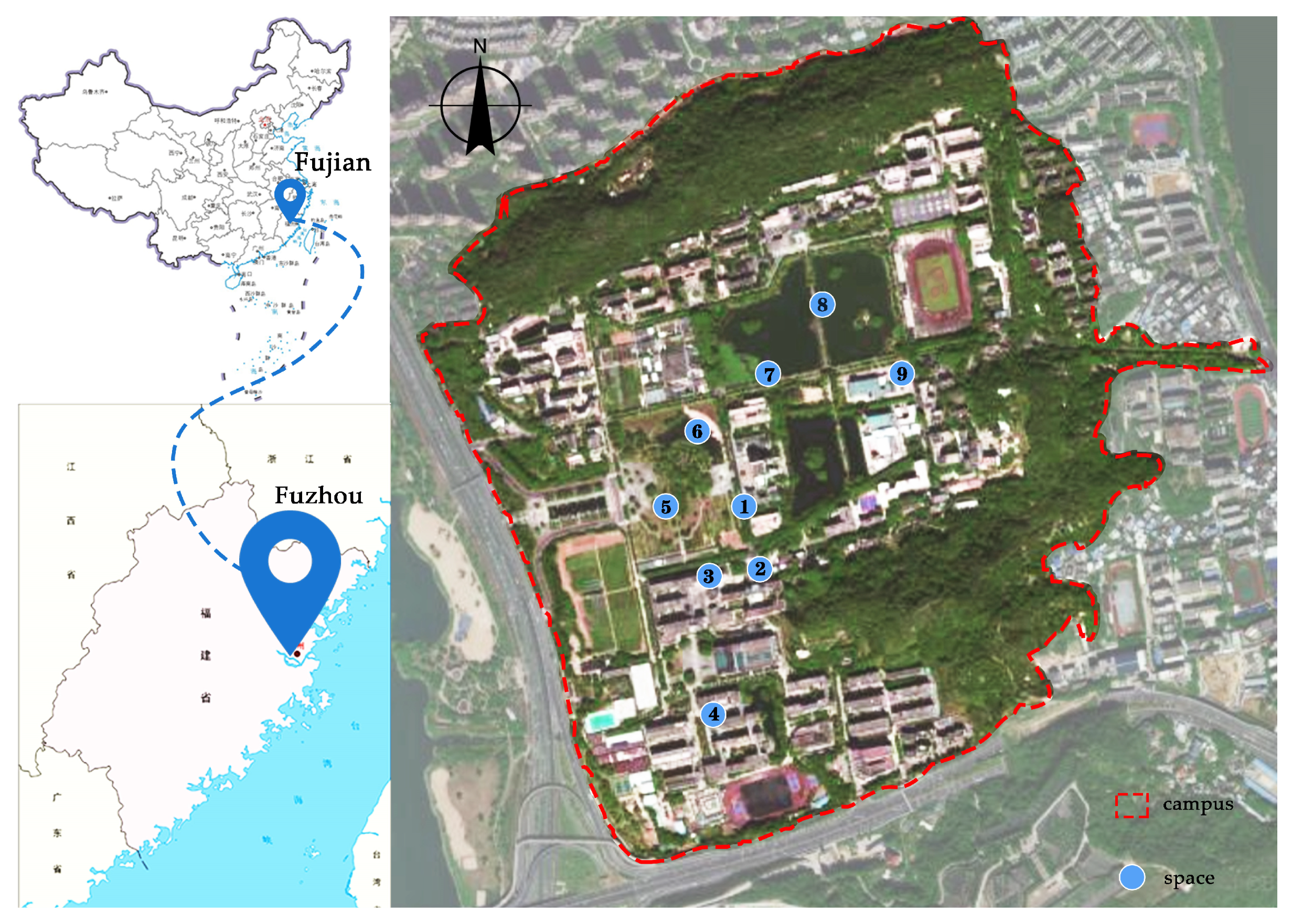
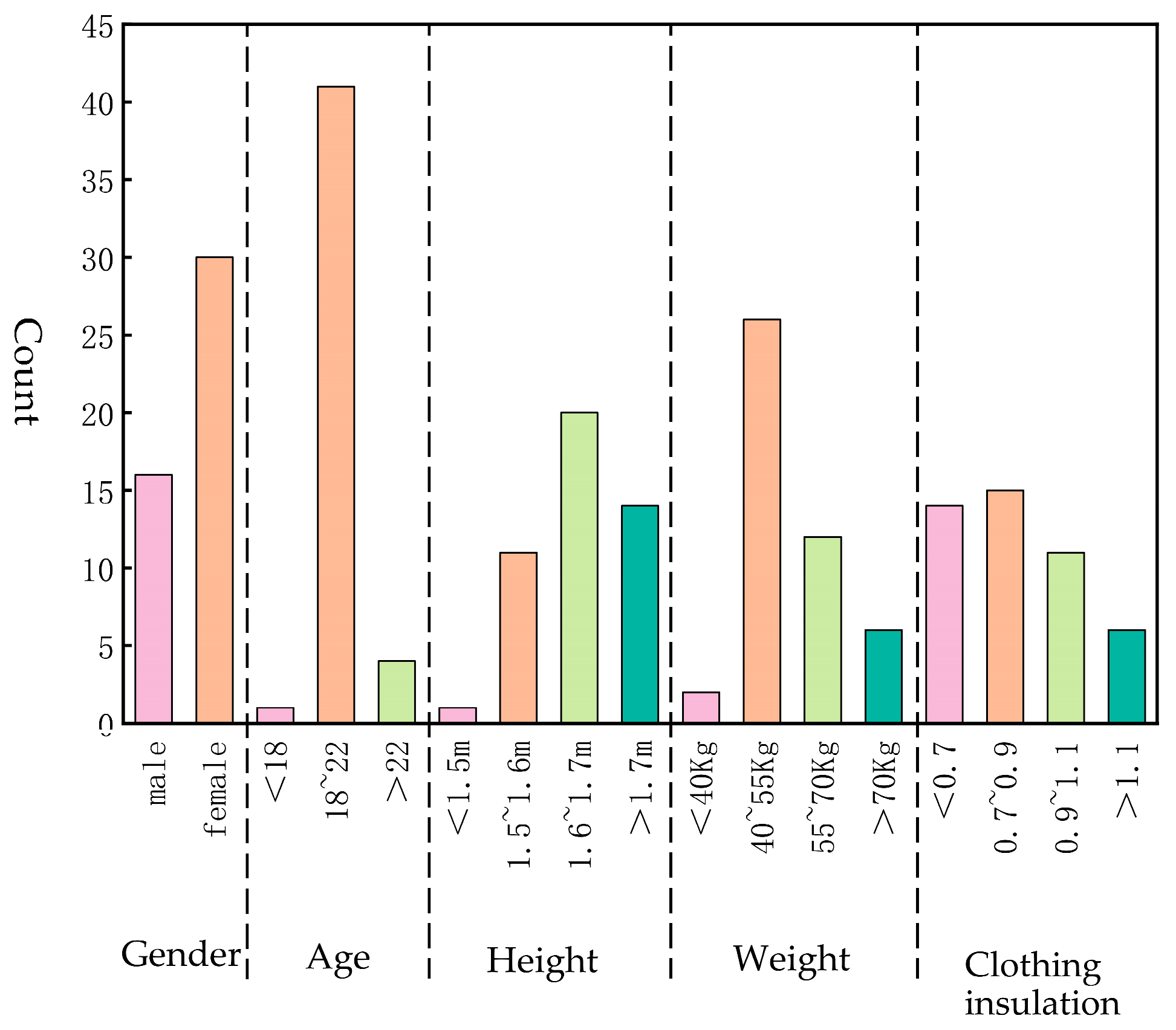


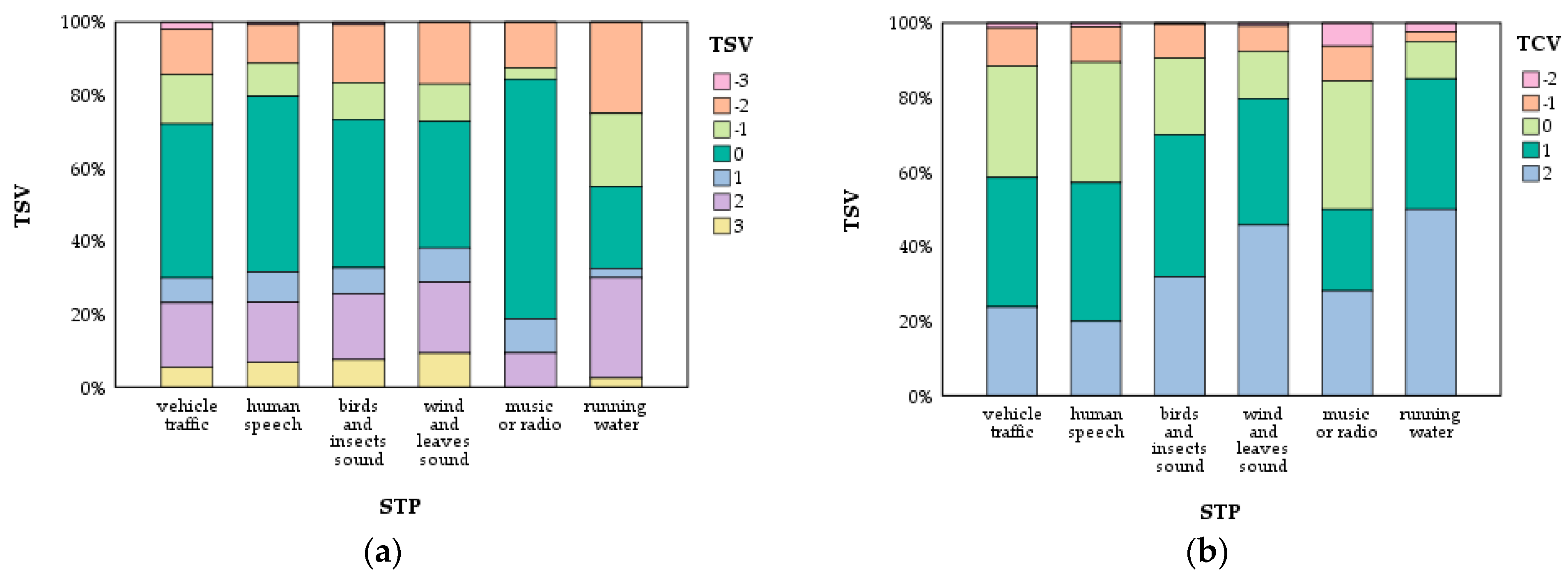
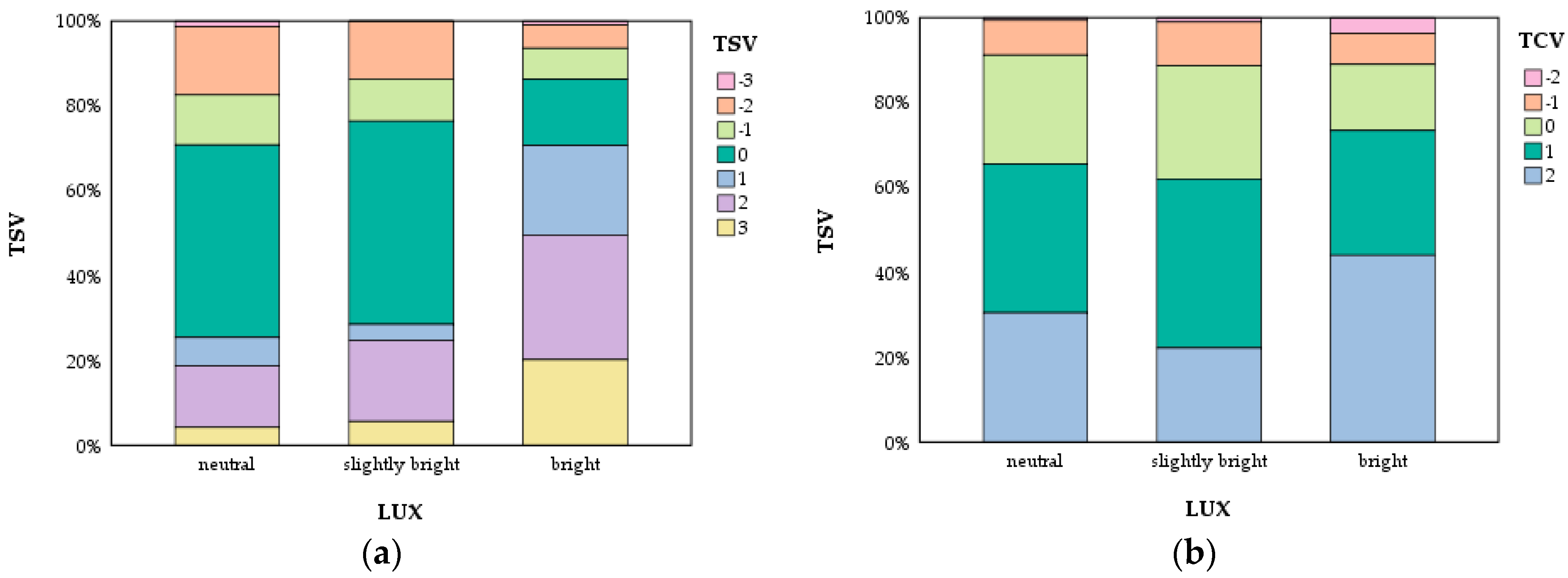




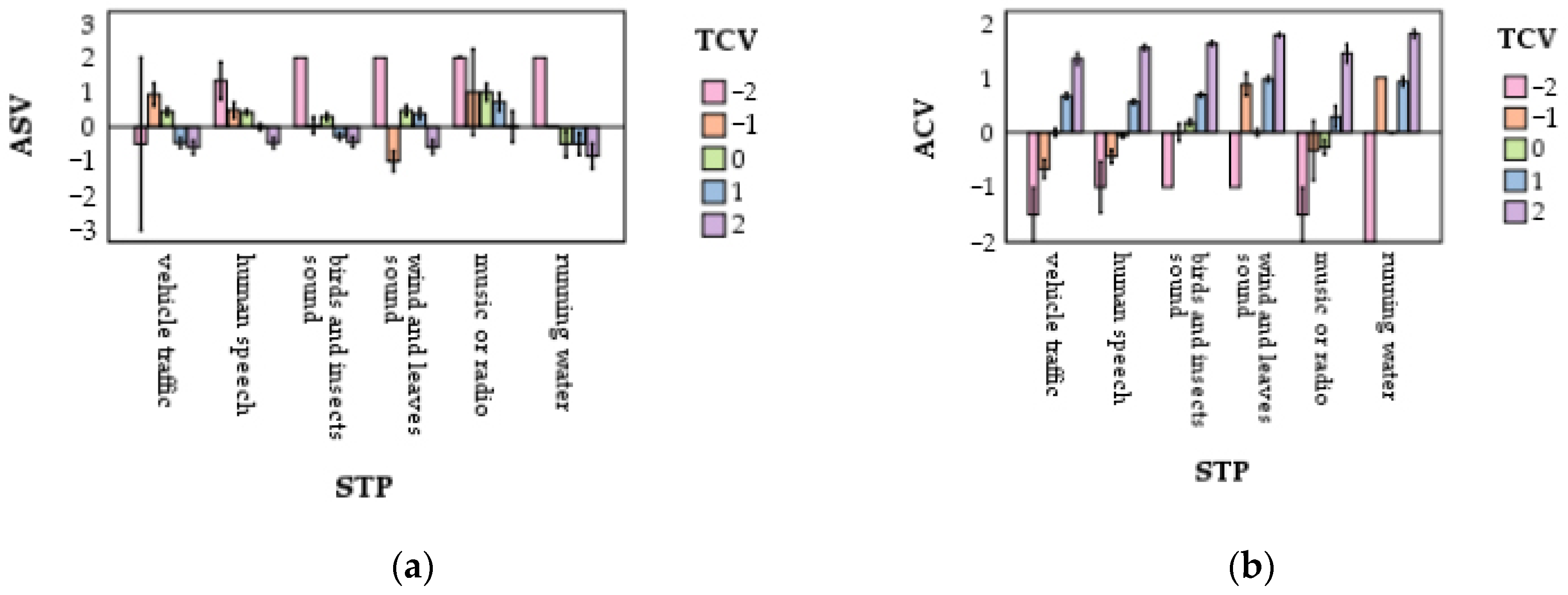




| Space | SVF | Fisheye Photo | Characteristics |
|---|---|---|---|
| S1 | 0.240 | 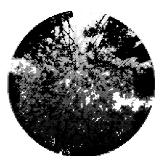 | The site is located under the campus administration building and is the leading traffic path for students to attend classes. The banyan tree serves as a street tree and provides shade all year round, creating a more enclosed space. |
| S2 | 0.370 |  | The Innovation Building atrium is located under the main academic buildings on campus, connected by a footbridge to form a grey space underneath. It is predominantly hard-paved, with a green belt of shrubs planted around the building. It is a staging plaza for students to go to and from classes. |
| S3 | 0.453 |  | The site is located in front of the Tian Jia Bing teaching building to the north and west, is surrounded by no greenery, and is dominated by a large amount of hard paving, which, unlike S2, is not sheltered at the top of the site. |
| S4 | 0.396 |  | The site is located in the open space of the Chengzhi building complex. Tall school buildings block the east and west sides. There is a pavilion in the green space, and the surrounding area is planted with cherry blossoms, purple leaf plums, large-flowered violets, other flowering trees, rhododendrons, grey spaces, and other shrubs, which have a good landscape effect. |
| S5 | 0.848 |  | The site is located on the open lawn of the campus Zhonghua Garden. It is surrounded by no building shelter and is planted with trees such as Sapindales, golden treasure trees, Camphor trees, etc. It is a place for students to rest, play, and communicate with each other. |
| S6 | 0.245 | 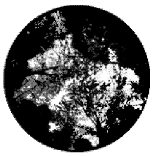 | The site is located in the interior of the Zhonghua Garden, surrounded by running water; evergreen trees and deciduous trees are planted together, and the ground is grass, which creates a good landscape effect, and it is a place for students to take a walk for leisure and study by memorizing books. |
| S7 | 0.330 |  | The site is located on Jinshan Road, south of Guanyin Lake, and is lined with plantings of white orchids, which partially block the view of the school building to the south. Permeable pavers dominate the sidewalk and are the main traffic path for the school. |
| S8 | 0.526 |  | The site is located inside the Zhonghua Garden, surrounded by running water. Evergreen and deciduous trees are planted together to form a good landscape effect. This is a place for students to take a walk, relax, and study by memorizing books. |
| S9 | 0.699 |  | The site is located in Topping Square, with the main building, the Great Hall, to the west. Unobstructed on three sides, with a representative sculpture in the center of the square, it is one of the school’s leading event venues. |
| Instrument | Parameters | Range | Precision |
|---|---|---|---|
| HOBO S-THC-M002 | Air temperature; relative humidity | −40~+75 °C; 0%~100% | ±0.25 °C; ±2.5% |
| HOBO S-WCF-M003 | Wind speed | 0~76 m/s | ±1.1 m/s |
| HOBO S-LIB-M003 | Global radiation | 0~1280 W/m2 | ±10 W/m2 |
| TA632A/B | Illumination intensity | 0.1~200,000 LUX | ±(3% + 5 LUX) |
| JT2011 | Globe temperature | 0~120 °C | ±0.5 °C |
| X2 | df | Sig. | ||
|---|---|---|---|---|
| Thermal Sensation Vote | Acoustic Sensation Vote | 65.495 | 36 | 0.000 * |
| Acoustic Comfort Vote | 70.275 | 24 | 0.000 * | |
| Sunlight Sensation Vote | 133.965 | 36 | 0.000 * | |
| Visual Comfort Vote | 52.598 | 24 | 0.000 * | |
| Thermal Comfort Vote | Acoustic Sensation Vote | 96.515 | 24 | 0.000 * |
| Acoustic Comfort Vote | 305.340 | 16 | 0.000 * | |
| Sunlight Sensation Vote | 35.999 | 24 | 0.000 * | |
| Visual Comfort Vote | 256.918 | 16 | 0.000 * | |
| Acoustic Sensation Vote | Sunlight Sensation Vote | 44.521 | 24 | 0.010 |
| Visual Comfort Vote | 47.523 | 16 | 0.000 * | |
| Acoustic Comfort Vote | Sunlight Sensation Vote | 27.059 | 24 | 0.233 |
| Visual Comfort Vote | 201.912 | 16 | 0.000 * |
Disclaimer/Publisher’s Note: The statements, opinions and data contained in all publications are solely those of the individual author(s) and contributor(s) and not of MDPI and/or the editor(s). MDPI and/or the editor(s) disclaim responsibility for any injury to people or property resulting from any ideas, methods, instructions or products referred to in the content. |
© 2024 by the authors. Licensee MDPI, Basel, Switzerland. This article is an open access article distributed under the terms and conditions of the Creative Commons Attribution (CC BY) license (https://creativecommons.org/licenses/by/4.0/).
Share and Cite
Li, S.; Zhang, Y.; Zhang, Q.; Xue, P.; Wu, H.; Xu, W.; Ye, J.; Chen, L.; He, T.; Zheng, Y. Exploring the Multi-Sensory Coupling Relationship of Open Space on a Winter Campus. Forests 2024, 15, 876. https://doi.org/10.3390/f15050876
Li S, Zhang Y, Zhang Q, Xue P, Wu H, Xu W, Ye J, Chen L, He T, Zheng Y. Exploring the Multi-Sensory Coupling Relationship of Open Space on a Winter Campus. Forests. 2024; 15(5):876. https://doi.org/10.3390/f15050876
Chicago/Turabian StyleLi, Shumin, Yijing Zhang, Qiqi Zhang, Pingting Xue, Hao Wu, Wenjian Xu, Jing Ye, Lingyan Chen, Tianyou He, and Yushan Zheng. 2024. "Exploring the Multi-Sensory Coupling Relationship of Open Space on a Winter Campus" Forests 15, no. 5: 876. https://doi.org/10.3390/f15050876
APA StyleLi, S., Zhang, Y., Zhang, Q., Xue, P., Wu, H., Xu, W., Ye, J., Chen, L., He, T., & Zheng, Y. (2024). Exploring the Multi-Sensory Coupling Relationship of Open Space on a Winter Campus. Forests, 15(5), 876. https://doi.org/10.3390/f15050876






